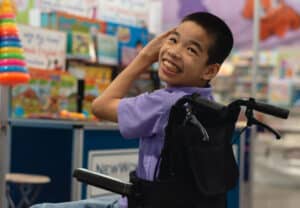
Structuring your self-contained classroom can take quite a bit of planning and organization to make sure that a supportive and engaging learning environment is the result. While students with low incidence disabilities in your classroom may have similar academic needs, each student still requires personalized instruction – which can make striking a balance between overall classroom structure and maintaining individual needs challenging.
In this blog, we’ll provide you with different measures you can take to build a classroom environment that enhances instructional time, strengthens independence, promotes positive behaviors and maximizes student outcomes!
First things first! When you begin to organize your classroom and plan your daily routines, consider the structure of the curriculum you will use. For example, TeachTown’s enCORE incorporates both whole group and small group instruction. It also serves as a blended learning model that utilizes both technology and print lessons. How will you (physically) lay out your classroom to accommodate small group work and where will the technology live? Another important thing to think about is the possibility of scheduling routine time blocks for instructional breaks.
As you start to build out your daily routine, define learning areas in your classroom that will best support different areas of instruction. Do you want a library in your classroom that includes a reading corner? Great! What about a space where you can work on hands-on activities with students? You may need specific tables or seating areas to allow ample space and appropriate access for students who use wheelchairs, walkers, and/or other adaptive equipment. If you’re doing whole group instruction, can you create a space that also functions for small group instruction, as well? These are all things you’ll want to consider as you organize your self-contained classroom.
When you structure individualized workstations in your classroom, design the spaces based on your students’ preferences and requirements. Have a space where students can store their belongings and necessary materials for instruction, while also encouraging self-management and strengthened independence.
Similar to the idea of individualized workstations, consider creating a space for work bins or task boxes for your students. This will help you help your students gain a greater sense of independence and skills. If you go this route, you’ll want to make sure everything is clearly labeled with color coding or visual representations to support your students. Here’s a great example of how to accomplish this!
If you’re teaching in a self-contained classroom, it’s very likely you’ll want to incorporate sensory breaks throughout the day. Perhaps you’ll want to establish an area in your classroom where students can go to rest, take a breather, or stretch. You can set up a corner that has comfortable furniture, pillows, and calming music based on what your students’ sensory needs look like. It may also be helpful to include a bin with sensory toys or items designed to stimulate one or more of the five senses through various textures, weights, sounds, colors, and more. Regardless of how it is structured, sensory breaks are a great way for your students to self-regulate and refocus!
As you set up different workstations in your classroom, be sure to incorporate visual cues and supports wherever you can. Whether this includes pictures, schedules, timers, floor markers, etc. – the additional supports will certainly help guide your students as they move through your daily routine. The more familiar they are with the visual supports and expectations, the more likely they will be to move through tasks and transitions with ease.
Lastly, try to create a classroom structure that offers lots of opportunities for your students to work collaboratively and interact with their peers. Spaces that encourage group activities will help your students build their communication and sharing skills, as well as enhance their peer relationships.
With these tips in mind, you can create a structured and supportive self-contained classroom that meets the needs of your students and fosters their overall growth and development. The best part, though? If you find that something about your setup isn’t functioning in the way you’d hope it would, you can adjust. Nothing has to be permanent. In fact, it is wise to adapt to meet the needs of your students as they grow! You’ll know if your classroom setup is functioning well based on how your students are doing academically, socially, and behaviorally.
Happy planning!
Contributor Bio
